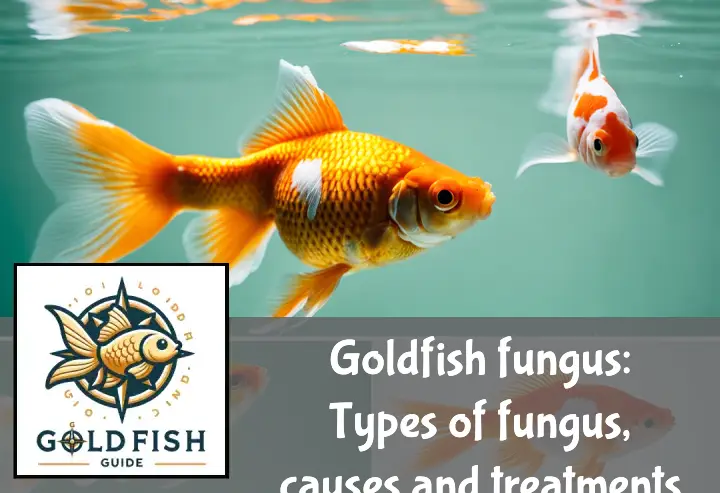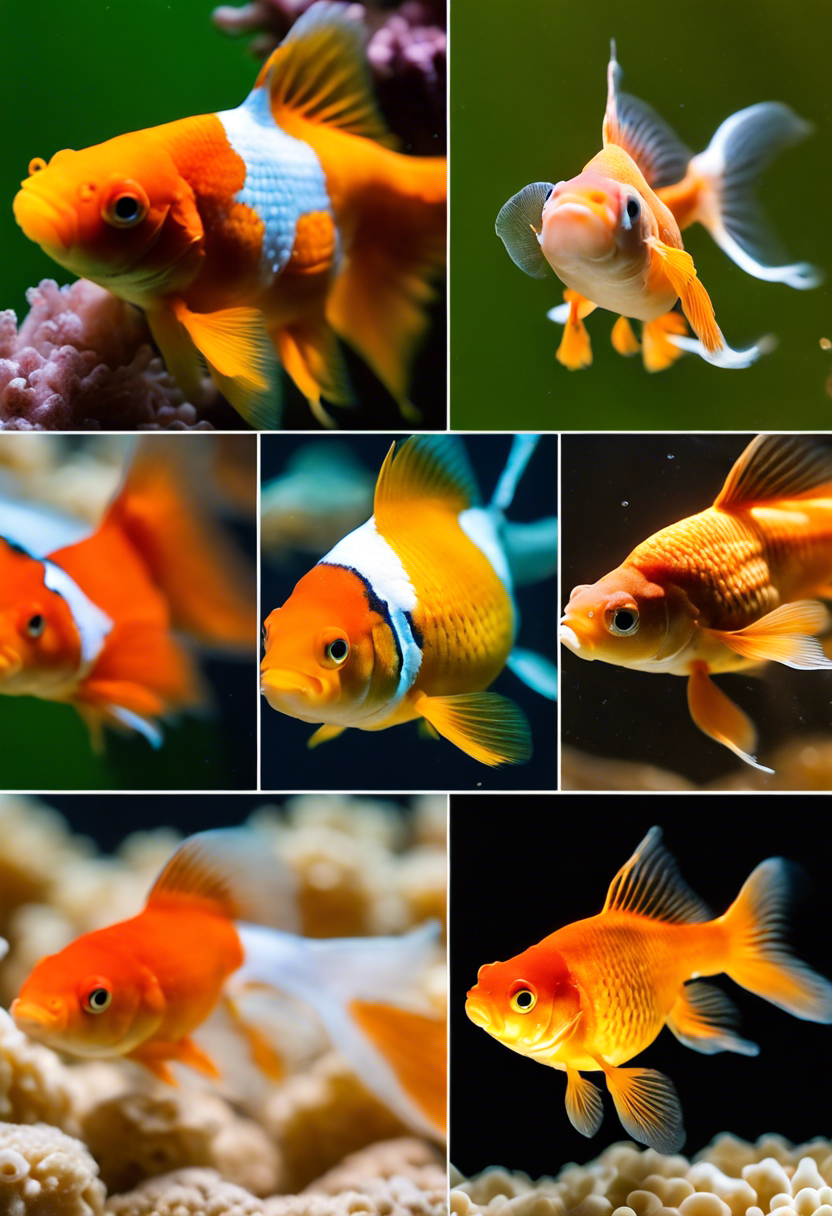Ever had that sinking feeling when you spot something unusual on your pet goldfish? It’s like a mini heart attack, isn’t it? Well, if that ‘something unusual’ resembles cotton wool or fluff, chances are your little finned friend might be dealing with Goldfish fungus.
Don’t panic! Although it sounds terrifying, it’s actually a common problem and there are ways to treat it. So take a deep breath and keep reading about Goldfish fungus: Types of fungus, causes and treatments. Let’s dive in!
Key Takeaways
- Goldfish can be affected by several types of fungus, including Saprolegnia and Branchiomyces.
- Fungal infections in goldfish are often caused by poor water quality, stress, or injury.
- Symptoms include cotton-like growths on the fish’s body, loss of appetite, and lethargy.
- Treatment involves improving water conditions and using antifungal medications like Methylene Blue or Pimafix.
- In severe cases, a vet may need to administer injections or perform surgery.
What is Goldfish Fungus?
If you’re a goldfish owner, goldfish fungus might be a term that sends shivers down your spine. It’s a big deal in the world of goldfish health, and it’s not something to take lightly.
Defining Goldfish Fungus
So, what exactly is this spooky-sounding thing? Well, goldfish fungus is essentially a type of fungal infection that can affect our little fishy friends. It’s not some mythical creature from an underwater horror movie, but rather an all-too-real threat lurking in many an aquarium.
This nasty invader, also known as aquarium fungal infection, can cause all sorts of problems for your gilled buddies. From irritating their skin to causing serious health issues, it’s definitely not something you want to find in your fish tank.
The Biological Aspect of Goldfish Fungus
Now let’s dive a bit deeper into the science-y stuff – the biological aspect of goldfish fungus. On a cellular level, this fungus wreaks havoc on your goldfish’s body. It starts by attaching itself to the fish’s scales and then begins its destructive path.
The fungus penetrates the outer layers of the fish’s skin and starts damaging cells left and right. This invasion can lead to significant health problems for your goldie – everything from loss of appetite to more severe conditions like systemic infections.
In other words, this isn’t just some minor annoyance for your pet; it’s a serious threat to their overall health. So next time you hear about goldfish diseases or see signs of fungus in your fish tank, remember: it’s not just about aesthetics – it’s about keeping our finned friends healthy and happy!
What are the Different Types of Fungus in Goldfish?
When it comes to goldfish fungal infections, there’s a whole underwater world of creepy crawlies. These aren’t your garden-variety mushrooms, though! We’re talking about microscopic organisms that can cause some serious issues for our aquatic pals. Let’s dive into the details.
Saprolegnia
First up, we have Saprolegnia. This bad boy is like the boogeyman of the goldfish world. It shows up as a white cottony growth on fish, making your goldfish look like it’s wearing a fluffy winter coat – not exactly the fashion statement you want them to make!
This fungus doesn’t just affect their looks though; it can also lead to other health problems. If left untreated, it can cause ulcers and even death. So if you spot any white fluff on your goldfish, don’t ignore it!
Branchiomyces
Next on our list is Branchiomyces. This one’s a bit more insidious because it targets the gills – hence its nickname ‘gill rot disease’. Your goldfish might start gasping for air or swimming erratically if they catch this nasty bug.
The worst part? It’s hard to spot until it’s too late. By the time you notice something’s off with your fishy friend, they could be in serious trouble. So remember folks, keep those water conditions pristine to avoid any unwanted visitors!
Ichthyophonus
Last but not least, we have Ichthyophonus hoferi. Now this one sounds like something out of a sci-fi movie, but trust me, it’s all too real for our finned friends.
This fungus causes systemic mycosis in fish – basically an internal fungal infection that can wreak havoc on their little bodies from the inside out. It’s not a pretty sight, and it can be really tough to treat. So keep an eye out for any unusual behavior or signs of distress in your goldfish.
What Causes Fungal Infections in Goldfish?
Ever wondered what causes those nasty goldfish fungal infections? Well, it’s usually a combination of poor water quality, stress leading to a weakened immune system, and physical injuries or wounds.
Poor Water Quality
Poor water quality is like the number one villain in the story of goldfish diseases due to bad water. When the aquarium water parameters go haywire, it creates an environment where fungus thrives. It’s like inviting unwanted guests to a party and then wondering why things are going downhill.
The effects of poor water quality on fish health can be devastating. It’s like living in a smog-filled city without an air purifier. Not fun at all for our finned friends!
Stress and Weakened Immune System
Stress isn’t just a human problem; goldfish feel it too! And just like us, chronic stress can weaken their immune system. Imagine your goldfish constantly feeling like it’s Monday morning – that’s enough to make anyone sick!
The impact of stress on fish health is significant. A stressed-out goldfish is more susceptible to diseases, including those pesky fungal infections.
Physical Injury or Wounds
Physical injuries or wounds are another cause of fungus in fish. Think about it: if you had an open wound, you’d be at risk for infection too, right? The same goes for our aquatic pals.
A wound provides an easy entry point for fungi and other nasties. So if your goldfish looks like it got into a bar fight with a catfish, keep an eye out for signs of infection!
How to Identify a Fungal Infection in Your Goldfish?
Spotting a goldfish fungal infection early can save your finned friend from discomfort and even death. It’s all about knowing what to look for and acting quickly. Let’s dive into the telltale signs of fish disease that should have you on high alert.
Visible Symptoms
When it comes to fish fungus symptoms, your goldfish might start sporting some new, unwanted accessories. You may notice white patches on fish or changes in skin color that weren’t there before. These could be the first signs of trouble brewing in your aquarium.
But don’t stop at just color changes. Keep an eye out for spots or patches that seem out of place. If your goldfish looks like it’s been dabbling in punk fashion with random patches, it might be time to worry about aquarium fungus identification.
Behavioral Changes
Now, let’s talk behavior because even fish can act strange when they’re not feeling well. One sign of a potential fungal infection is if your goldfish starts swimming like it’s auditioning for a circus act. Unusual swimming patterns are often a red flag indicating something’s off in terms of goldfish health.
Another thing to watch for is if your goldie suddenly loses its appetite. If it starts ignoring food like a teenager ignoring chores, you might have a case of sick goldfish symptoms on your hands. Remember, abnormal behavior is often an SOS signal from our aquatic pals!
How to Treat Fungal Infections in Goldfish?
When it comes to goldfish fungus, there’s no one-size-fits-all treatment. But don’t worry, we’ve got a few tricks up our sleeves! From over-the-counter medications to natural remedies and preventive measures, let’s dive into the world of goldfish fungal treatment.
Over-the-Counter Medications
First stop on our tour is the pet store aisle filled with aquarium fungus medicine. These over-the-counter treatments are a godsend for many fish parents. They’re easy to use – just follow the instructions on the package.
But remember, not all fish antifungal medication is created equal. Some are better suited for certain types of fungi than others. So, do your homework before you buy!
Natural Remedies
If you’re more of a DIY kind of person, there are also some natural fish fungus remedies you can try. For instance, salt baths can help treat minor fungal infections in goldfish.
However, keep in mind that these homemade fish fungus treatments may not be as effective as their pharmaceutical counterparts. But hey, they’re worth a shot if you’re looking for an organic goldfish disease cure!
Preventive Measures
Finally, let’s talk about prevention because honestly, it’s easier to prevent a problem than fix it! Keeping your aquarium clean is key in preventing goldfish diseases.
Regular water changes and proper feeding habits can go a long way in keeping that pesky fish tank fungus at bay. And remember – happy fish live in happy tanks! So make sure your aquarium hygiene practices are up to snuff.
To Wrap Up
In the grand fishbowl of life, goldfish are like the toddlers who touch everything, making them prone to picking up unwanted fungal hitchhikers. Remember, prevention is better than cure when it comes to Goldfish fungus.
So keep an eye on your finned friends and their environment. A clean tank and a healthy diet can go a long way in keeping your goldfish fungus-free. After all, a happy goldfish is a healthy goldfish!



